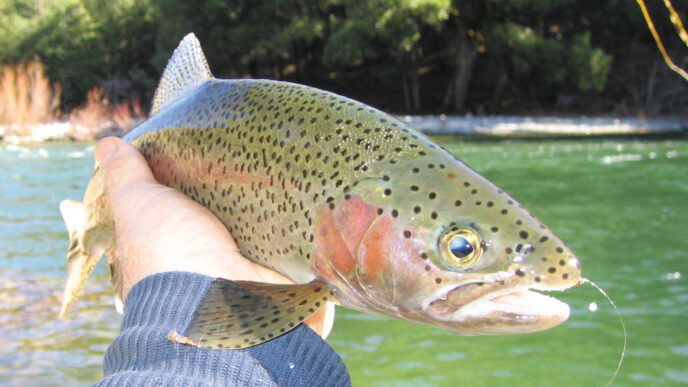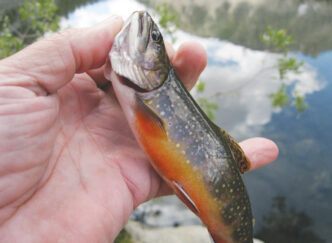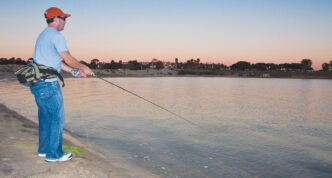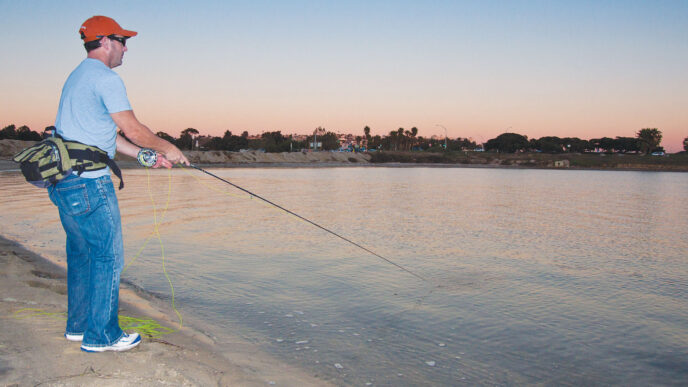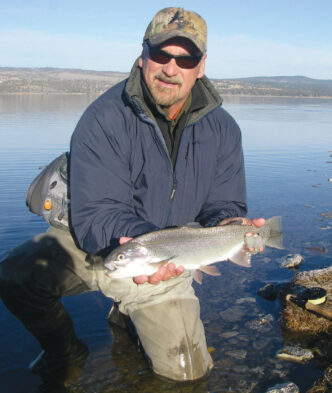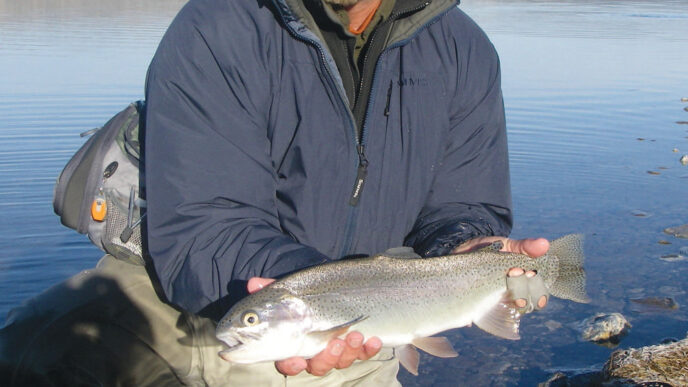Last spring, several of my fishing buddies and I camped on the edge of a cove on a local foothill lake.
We find it best to camp where our small skiffs can be tied up to the shoreline overnight so we can fish the early and late bite. There’s also the added pleasure of being right on the water and the close proximity of the sounds of Mother Nature. A bass outing, camping, and particularly good outdoor meals are an important part of a spring ritual that has been taking place for over 30 years.
We had fished the afternoon of our arrival with a degree of success, had grilled steaks for dinner on open coals, and had returned to the water for another 40 minutes of late-light fishing. The skiffs now were secured for the night, and we threw more oak on the fire to settle in for a nightcap and some tall-tale telling.
The chosen subject for the evening was unusual fly-fishing experiences. As it turned out, I was last in line. I was at wits’ end thinking of a good tale when frogs started croaking in the evening quiet. Big ones bellowed their amorous greetings. Little creatures chirped a melodious chorus. It was good to know that relatively close to home, we could feel as if we were a million miles away, and it gave me an idea for a tale when my turn came around the campfire.
In 1967, 1968, and 1969, the air force stationed me in the Philippines. Monthly duty took me on a circuit north across the central Luzon plain to the mountain community of Baguio, where we had a small air base named Camp John Hay. I made the long drive, did three days of dental sick call, then headed west down the five-thousand-foot mountains on a tortuous road to San Fernando La Union. A few miles north, a tiny outpost called Poro Point sat on a finger of land that jutted out into the South China Sea. I did another day and a half of dental work at the small, secret radar base that peered across the sea into North Vietnam and China. On the last day of one visit, I shook off the ragged edge that came with the oyster roast that the 60 people-starved men always threw for visitors, did a supply inventory, packed up, and braced for the long drive home on rural Third World roads, which took me through several provincial towns and what seemed like a hundred barrios.
Two-thirds of the way back to sprawling Clark Air Force Base, I was succumbing to the torrid heat and humidity and needed a stretch and something cold. A wide spot loomed ahead with a turnout and a small sari-sari store — the local version of a convenience store or bodega — that looked like it might have ice and San Miguel. I parked and was happy to find the beer cold, but my eyes caught sight of an intriguing petite woman behind the little thatched-roof store, standing in a wide, reed-filled ditch that bordered a flooded rice paddy. Several Asian water buffalos rooted a hundred or so meters up the ditch. Levy Sarmiento was a withered old woman who was being bypassed by the generation that she had spawned. Her husband was dead. He was in the Philippine Resistance during World War II and was killed on Bataan by Japanese soldiers. When my eyes first met hers, they had moved up from her legs, immersed in the watery ditch on the outskirts of a small barrio in rice country north of Tarlac Province, to knobby, arthritic knees above skinny calves. There wasn’t an ounce of fat on her emaciated frame. Matted black hair that had once been silky and raven-colored reached beyond her slumped shoulders. She held a thin brown cigar between lips that protected red, betel-nut-stained teeth.
Whips of blue smoke spiraled up toward a rare cloudless sky.
When I walked toward her, a charismatic grin spread from ear to ear. She reached into her threadbare, sleeveless shift that tried to protect her from the tropical sun and produced another cigar. Thus began a friendship that would span my military obligations in the Philippines and would teach me how to catch frogs with a fly and then cook them for dinner.
Though Levy was long past childbearing age and would have been a burden for many extended peasant families, she earned her spot in the barrio nipa hut, the indigenous house of the Philippines, because she had a unique skill that provided protein. Levy was brilliant at catching frogs from roadside ponds and ditches.
It was her armamentarium that piqued my curiosity that day. She held a 15-foot bamboo pole, to which was attached a thin bit of rayon cord, a short tip of clear monofilament fishing line, and a fish hook adorned with a piece of split red cloth.
After a few drags on our cigars, Levy asked, “What GI doin’ here in barrio?” I told her in broken night-school Tagalog that I traveled the road each month on the way to and from San Fernando La Union. I had stopped for a cold San Miguel and was fascinated by her fishing rig . . . that I was a fisherman at home, and I appreciated her skills. She took another drag and asked what I did for work. I replied, “Dentista.” She grinned with her few remaining teeth.
In a subsequent dialogue in abbreviated broken English and abbreviated broken Tagalog, I was invited to stop on my next trip and learn how to catch frogs. I did so the following month and also spent a night sleeping on the hard split-bamboo nipa hut floor after sharing a meal with the Sarmiento family and tossing down more than a few glasses of “shakemup,” a coconut-milk brew made with very cheap local alcohol that came from the sugar cane fields. That evening’s talk about life in the Philippines was an insightful one that will remain with me the rest of my life.
Over the years since then, I have caught frogs in the way that Levy taught me there, barefoot in the ditches and rice paddies. During the day and periods of low light, you have to seduce your quarry. It was with eyes that were still keen and an array of vertical retrieves that Levy earned her reputation for being so good at her job of enticing wary frogs. At night, though, the frogs are more aggressive and likely to take your “fly.” You may vector in on their croak and hope for a blind strike. In the Philippines, I tried not to think about the pythons that also lived in the ditch.
When we fished together, I told Levy that we used lures in a similar way to catch an aggressive fish that we called a “bass.” I saw Levy now and then for almost a year, until I was assigned to surgical duty and my hinterland trips disappeared. I always stopped, smoked thin cigars, and left canned goods for the Sarmiento family. I brought rice-growing brochures that I requested from U.C. Davis, and when I could stay the night, we had spirited discussions about land reform and the Hukbalahap revolutionary movement that was gaining popularity and territory in the provinces north of dictator Ferdinand Marcos’s Manila.
In Asia, karma visits in unpredictable ways. Luck or lack thereof would have it that I was captured by a squad of armed Huks while on a monkey-photo safari adventure in the western mountains not too far from Levy’s home. The Huks released my friend and me after we sat in a clearing and shared all our picnic lunch, snacks, and a case of Budweiser in the new red cans. The soldiers thought that the red cans were really cool. The truth was that I sympathized with them. I remember musing over the fact that in Army ROTC, I had trained on a Browning automatic rifle similar to the ones carried on the shoulders of several squad members. Thank God for the night school Tagalog classes and the spirited discussions and language practice at Levy’s where I learned of the peasant’s plight. We were released unharmed, short most of a case of Bud.
In the Philippines, a little bit of protein had to be stretched a long way. Often, frogs’ leg meat was diced and stir fried with onions, garlic, a few shreds of pimento and tossed with noodles in a classic pansit canton. If the hunting was good, wok-fried frog meat, again with lots of garlic, wound up on a plate of rice.
Today, in California, several of the 50 or so species of frogs in the state are listed on federal and state endangered species lists. The only frogs that are commonly large enough to eat are the California redlegged frog of the valley and foothills, Rana draytonii, which was honored in Mark Twain’s 1865 “Celebrated Jumping Frog of Calaveras County” and which is listed as a threatened species and is protected by California law, and the introduced American bullfrog, Rana catesbeiana, which remains legal to catch and which is worth the effort for a meal, particularly for a meal served around a campfire on the edge of a foothill lake. A basic steelhead rod works quite well, with a line, leader, hook, and that strip of red cloth, which supposedly goes back all the way to Macedonia and the origins of fly fishing. Better yet would be one of the newer switch or Spey rods. But a time-tested 15foot bamboo pole still performs just fine.
The Sierra yellow-legged frog, Rana sierra, otherwise known as the mountain yellow-legged frog, is protected and too small to make it worth eating — unless you are a planted brown or rainbow trout. It is the amphibian that has caused the lawsuits against stocking mountain lakes, because stocked trout supposedly have depleted its numbers. Certainly the tadpole and juvenile forms of all species of frogs make up a huge portion of the aquatic food chain for many species of fish throughout the state in many ecosystems.
I’m not as limber as I once was, so my nighttime frog-catching days are over, but I’ve found that my butcher can order them. Specialty and Asian food markets commonly stock frozen frogs’ legs or even hold frogs in live tanks. I have a bit of French blood in me, so the Provençal style is a good way of preparing the low-fat meat of the grenouille. Remember that the French were the second most common ethnic group to come to California and contributed greatly to our early society. The preparation is simple and is very suitable for cooking in a camp skillet for a special meal. Still, distant urges from 40 or so years ago bring out the wok, and my wife and I sometimes stir up a platter of pansit canton with frog bits, pimento, garlic, onions, and noodles. But the recipe for frogs in the style of Provençe is as simple as it gets, delicious, and works well for a fast camp meal.
Provençal-style Frogs’ Legs
600 grams or so of frogs’ legs — 1.25 to 1.5 pounds
Olive oil
Butter
Flour
Garlic and parsley, hashed together
Lemon juice
Salt and pepper
Roll the cleaned frogs’ legs in flour and toss them into a frying pan with the heated oil and butter. Sauté at high temperature, seasoning with salt and pepper. When the frogs’ legs turn golden, add the hashed garlic and parsley. Serve with drizzled lemon juice.
Heed the advice to sauté at a high temperature. Lower temperatures leave the frogs oily. Scraps and remains go well in your crawdad trap.







